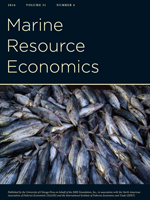This article uses the propensity-score matching method to examine the effects of a government subsidy program on the profitability of fisheries. The effects are analyzed at the individual vessel level through representative surveys of costs and earnings. Bioeconomic theory and a vessel economics framework for open-access fisheries are the basis for the empirical discussion of a case study involving Vietnam's offshore gillnet fishery. The results demonstrate that the subsidy program has positive effects on vessel profitability, but the profits erode over the two years of the analysis. Subsidies have a positive impact on the operating cash flows of large vessels but negative effects on their intra-marginal rent, and bring benefits to vessel owners rather than crew members. This study reports on the first treatment evaluation of subsidies in a Southeast Asian fishery and discusses evidence that fish stocks may be biologically overfished.
JEL Codes: C31, D01, Q22, Q28.





